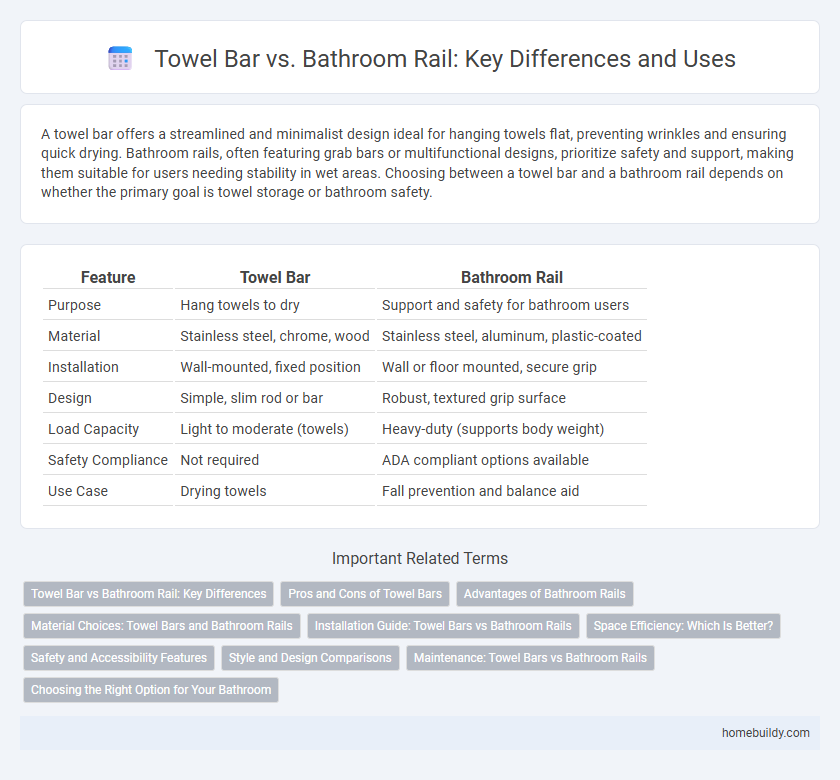A towel bar offers a streamlined and minimalist design ideal for hanging towels flat, preventing wrinkles and ensuring quick drying. Bathroom rails, often featuring grab bars or multifunctional designs, prioritize safety and support, making them suitable for users needing stability in wet areas. Choosing between a towel bar and a bathroom rail depends on whether the primary goal is towel storage or bathroom safety.
Table of Comparison
| Feature | Towel Bar | Bathroom Rail |
|---|---|---|
| Purpose | Hang towels to dry | Support and safety for bathroom users |
| Material | Stainless steel, chrome, wood | Stainless steel, aluminum, plastic-coated |
| Installation | Wall-mounted, fixed position | Wall or floor mounted, secure grip |
| Design | Simple, slim rod or bar | Robust, textured grip surface |
| Load Capacity | Light to moderate (towels) | Heavy-duty (supports body weight) |
| Safety Compliance | Not required | ADA compliant options available |
| Use Case | Drying towels | Fall prevention and balance aid |
Towel Bar vs Bathroom Rail: Key Differences
A towel bar typically features a single horizontal rod designed specifically for hanging towels within easy reach, providing a sleek and minimalistic look. In contrast, a bathroom rail often serves multiple purposes, such as offering support for balance or safety while doubling as a towel holder, usually made from sturdier materials and mounted more securely. The key difference lies in functionality, with towel bars emphasizing towel drying and bathroom rails prioritizing safety and accessibility.
Pros and Cons of Towel Bars
Towel bars offer a sleek, space-efficient solution for drying towels compared to bathroom rails, providing secure, horizontal support that helps towels dry quickly and stay wrinkle-free. However, towel bars require sturdy wall installation, which might not be suitable for all bathroom surfaces, and their fixed length can limit towel size compatibility. Unlike bathroom rails, towel bars typically do not support heavy loads or additional bathroom items, restricting their multifunctional use.
Advantages of Bathroom Rails
Bathroom rails provide enhanced safety and support compared to towel bars, especially for elderly or mobility-impaired users. Their robust construction and secure wall mounting offer reliable assistance when entering or exiting showers and bathtubs. Unlike towel bars, bathroom rails often feature non-slip surfaces and ergonomic designs, ensuring stability and reducing the risk of falls in wet environments.
Material Choices: Towel Bars and Bathroom Rails
Towel bars and bathroom rails are commonly crafted from materials such as stainless steel, aluminum, and brass, with stainless steel offering superior rust resistance in humid bathroom environments. Aluminum variants provide lightweight and corrosion-resistant options but may lack the strength needed for heavy-duty use compared to thicker brass models. Selecting materials with anti-corrosion coatings or finishes extends product longevity and maintains aesthetic appeal under frequent moisture exposure.
Installation Guide: Towel Bars vs Bathroom Rails
Towel bars typically require surface mounting on bathroom walls using screws and anchors, making them suitable for drywall or tile installations. Bathroom rails often involve more complex installation, necessitating precise stud alignment or wall reinforcement to support heavier loads and ensure safety. Proper measurement and level alignment are crucial for both, but bathroom rails demand sturdier anchoring due to their function as safety grab bars.
Space Efficiency: Which Is Better?
Towel bars typically offer better space efficiency compared to bathroom rails due to their streamlined design that fits flush against the wall, maximizing available space in small bathrooms. Bathroom rails, often bulkier and designed primarily for safety support, tend to require more room and can create visual clutter. Choosing a towel bar is ideal for optimizing space while maintaining functionality in compact bathroom layouts.
Safety and Accessibility Features
Towel bars and bathroom rails serve different purposes in safety and accessibility within bathroom spaces. Towel bars primarily function to hold towels, while bathroom rails are designed to provide stability and support, reducing the risk of slips and falls. Bathroom rails are often constructed with durable, non-slip materials and are strategically installed near showers or toilets to enhance accessibility for individuals with mobility challenges.
Style and Design Comparisons
Towel bars typically feature sleek, minimalist designs that seamlessly complement modern bathrooms, while bathroom rails often emphasize functionality with sturdier, more utilitarian aesthetics. The streamlined look of towel bars enhances visual appeal by maintaining clean lines, whereas bathroom rails may include textured grips or additional support features that prioritize safety over style. Selecting between the two depends on whether the bathroom design favors elegance and subtlety or robust practicality and user assistance.
Maintenance: Towel Bars vs Bathroom Rails
Towel bars typically require less maintenance than bathroom rails due to their simpler design and fewer moving parts, reducing the chances of corrosion or loosening over time. Bathroom rails, often made from stainless steel or chrome-plated materials for safety and durability, need regular inspection and cleaning to prevent rust and ensure secure mounting, especially in moist environments. Choosing corrosion-resistant finishes and frequently tightening mounting hardware can extend the lifespan of both towel bars and bathroom rails in bathroom settings.
Choosing the Right Option for Your Bathroom
Towel bars provide a sleek, space-efficient solution ideal for drying towels flat, while bathroom rails offer a versatile option that can double as safety support, especially in accessible bathroom designs. When choosing the right option, consider the bathroom size, user needs, and desired functionality; towel bars suit modern aesthetics and small spaces, whereas bathroom rails enhance safety and stability. Selecting between these options depends on prioritizing either towel drying efficiency or added safety features in your bathroom setup.
Towel bar vs Bathroom rail Infographic

 homebuildy.com
homebuildy.com